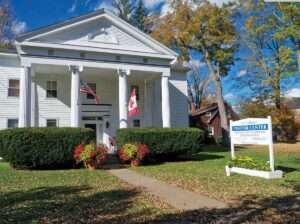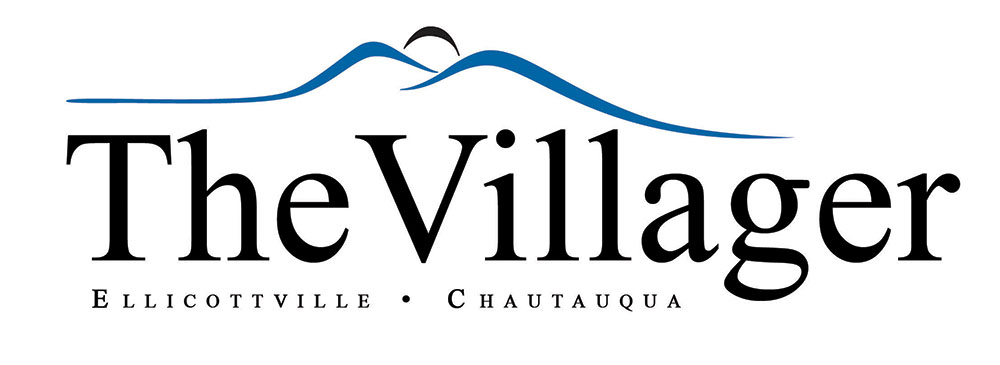By Carol Fisher-Linn
There is a wonderful walking tour guide of Ellicottville to be found at the Chamber building (known today as The Villager) or the Historical society. When we walk the streets of an historic village like Ellicottville, we must be filled with wonder as we imagine life, perhaps back in 1817 when the very first frame house was built in the village. I refer to the Leonard-Ellis-Harrison residence on 8 West Washington Street. Everything has a story. This building is no exception. It was built originally as an inn for the Holland Land Company as lodging for prospective land buyers. However, it did not pass muster with Holland Land Company as it cost too much money because lumber had to be brought down the creek to Ellicottville at additional expense. So, Baker Leonard, the hapless builder, ended up owning a rather large building in what was essentially the wilderness. Although there were no roads, no homes, no businesses to speak of, Leonard made lemonade out of his lemons and turned it into a residence, a tavern, a trading post for the local Indians, and, until municipal buildings were built, it served as the county courthouse. Imagine strolling around in 1817 and seeing that building. What might you be saying to your partner? What’s interesting about that building is that until this very day, it has remained in the hands of the same family.

By 1822, the Holland Land Company constructed what is now known as The Villager for its Cattaraugus County subagent, Stanley N. Clarke. Originally, it did not face W. Washington, but the entrance was redesigned to face Washington when the Classical Revival style portico with thee-story wooden columns was added in 1909. As usual, with these older frame buildings, it was almost destroyed by fire in 1973, yet still stands thanks to the concerned area residents who banded together to save this iconic building. Today, the building proudly houses several business offices, apartments, and offices for the Ellicottville Chamber of Commerce. She’s a proud, grand old girl.
The Inn at the northwest corner of the commercial district at 8-10 Washington Street has been the site of a hotel since 1822. The brick structure you see there today was a replacement for the previous wood frame inn that succumbed to the devastating fire of 1890 which took that whole block. Per the Historic Ellicottville Walking Tour, this was said upon completion of the new brick structure, “This is the finest hotel in western New York, with electric lights and steam heat.” Makes you want to smile imagining those days when electric lights and steam heat were unique, doesn’t it?
This story now brings me to a building that has left us only ashes along with curious questions, yet surely much history and tales passed down by those in Ellicottville who lived in that era. Once upon a time, in 1847 or even earlier, there stood a lovely three-story wood frame building on the corner of Monroe and E. Washington Streets. Irvine Hall remains a mystery (see page, 11). Here is what John Burrell submitted for this research: Pioneer Certificate applicant Charles R. Pettit is honoring tow Ellicottville ancestors, his great-great grandfather Amos Pettit and great-great grandfather James Smith Johnson. In March 1859, Amos Pettit became the host and manager of Irvine Hall Hotel, located on the corner of Washington and Monroe Streets. Now, Town Historian, Dawn Westfall, submitted this information: a gentleman by the name of James Harvey Metcalf seems to have run the tavern/hotel establishment Irvine Hall in Ellicottville at one point in 1847 according to an early newspaper ad. He also operated a grocery/dry goods store in Ellicottville in 1846 according to an ad dated November 18, 1846. On May 1, 1847, S. D. Nutting described his new stove, tin, copper and sheet-iron establishment in the village of Ellicottville as being “opposite J. H. Metcalfe’s Store and two doors below Irvine Hall.” Later on September 15, 1847, J. H. Metcalfe advertised that he had removed his goods to his new store “opposite the Post Office.”
Now, just sit back and imagine the parked buggies, the ladies in their finest dresses and parasols and gents in their top hats and tails attending galas that seemed to happen frequently at the Irvine. Dawn Westfall found an ad online for yet another dance but failed in purchasing it. What a fine piece of history that would have been for our historical society. From what we have been told, the building burned and that was the end of that story.
